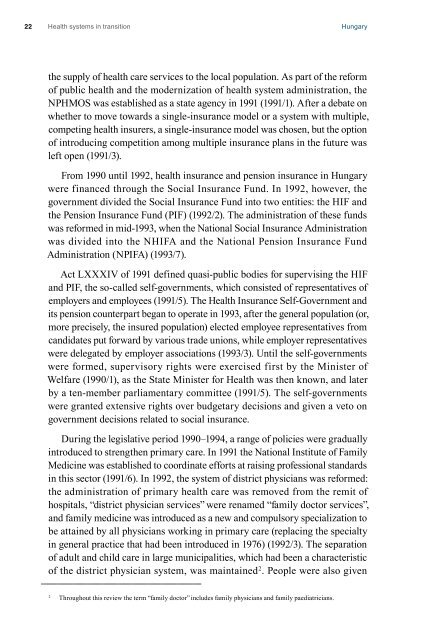Health Systems in Transition - Hungary - World Health Organization ...
Health Systems in Transition - Hungary - World Health Organization ...
Health Systems in Transition - Hungary - World Health Organization ...
Create successful ePaper yourself
Turn your PDF publications into a flip-book with our unique Google optimized e-Paper software.
22<br />
<strong>Health</strong> systems <strong>in</strong> transition <strong>Hungary</strong><br />
the supply of health care services to the local population. As part of the reform<br />
of public health and the modernization of health system adm<strong>in</strong>istration, the<br />
NPHMOS was established as a state agency <strong>in</strong> 1991 (1991/1). After a debate on<br />
whether to move towards a s<strong>in</strong>gle-<strong>in</strong>surance model or a system with multiple,<br />
compet<strong>in</strong>g health <strong>in</strong>surers, a s<strong>in</strong>gle-<strong>in</strong>surance model was chosen, but the option<br />
of <strong>in</strong>troduc<strong>in</strong>g competition among multiple <strong>in</strong>surance plans <strong>in</strong> the future was<br />
left open (1991/3).<br />
From 1990 until 1992, health <strong>in</strong>surance and pension <strong>in</strong>surance <strong>in</strong> <strong>Hungary</strong><br />
were f<strong>in</strong>anced through the Social Insurance Fund. In 1992, however, the<br />
government divided the Social Insurance Fund <strong>in</strong>to two entities: the HIF and<br />
the Pension Insurance Fund (PIF) (1992/2). The adm<strong>in</strong>istration of these funds<br />
was reformed <strong>in</strong> mid-1993, when the National Social Insurance Adm<strong>in</strong>istration<br />
was divided <strong>in</strong>to the NHIFA and the National Pension Insurance Fund<br />
Adm<strong>in</strong>istration (NPIFA) (1993/7).<br />
Act LXXXIV of 1991 def<strong>in</strong>ed quasi-public bodies for supervis<strong>in</strong>g the HIF<br />
and PIF, the so-called self-governments, which consisted of representatives of<br />
employers and employees (1991/5). The <strong>Health</strong> Insurance Self-Government and<br />
its pension counterpart began to operate <strong>in</strong> 1993, after the general population (or,<br />
more precisely, the <strong>in</strong>sured population) elected employee representatives from<br />
candidates put forward by various trade unions, while employer representatives<br />
were delegated by employer associations (1993/3). Until the self-governments<br />
were formed, supervisory rights were exercised first by the M<strong>in</strong>ister of<br />
Welfare (1990/1), as the State M<strong>in</strong>ister for <strong>Health</strong> was then known, and later<br />
by a ten-member parliamentary committee (1991/5). The self-governments<br />
were granted extensive rights over budgetary decisions and given a veto on<br />
government decisions related to social <strong>in</strong>surance.<br />
Dur<strong>in</strong>g the legislative period 1990–1994, a range of policies were gradually<br />
<strong>in</strong>troduced to strengthen primary care. In 1991 the National Institute of Family<br />
Medic<strong>in</strong>e was established to coord<strong>in</strong>ate efforts at rais<strong>in</strong>g professional standards<br />
<strong>in</strong> this sector (1991/6). In 1992, the system of district physicians was reformed:<br />
the adm<strong>in</strong>istration of primary health care was removed from the remit of<br />
hospitals, “district physician services” were renamed “family doctor services”,<br />
and family medic<strong>in</strong>e was <strong>in</strong>troduced as a new and compulsory specialization to<br />
be atta<strong>in</strong>ed by all physicians work<strong>in</strong>g <strong>in</strong> primary care (replac<strong>in</strong>g the specialty<br />
<strong>in</strong> general practice that had been <strong>in</strong>troduced <strong>in</strong> 1976) (1992/3). The separation<br />
of adult and child care <strong>in</strong> large municipalities, which had been a characteristic<br />
of the district physician system, was ma<strong>in</strong>ta<strong>in</strong>ed 2 . People were also given<br />
2 Throughout this review the term “family doctor” <strong>in</strong>cludes family physicians and family paediatricians.
















